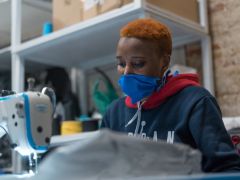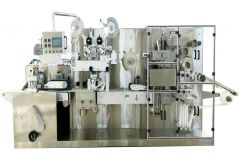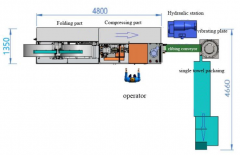Search results for: 'bag making mac'
- Related search terms
- Machine op
- Machine ope
- Machine+we
- Machine+fe
- machine''''
-
 D-2388 What’s the Best Material for a Mask?
D-2388 What’s the Best Material for a Mask?Federal health officials have now recommended that we cover our faces with fabric during the coronavirus pandemic. But what material offers the most protection?
The Centers for Disease Control and Prevention has posted a no-sew mask pattern using a bandanna and a coffee filter as well as a video on making masks using rubber bands and folded fabrics found at home.
While a simple face covering can reduce the spread of coronavirus by blocking outgoing germs from coughs or sneezes of an infected person, experts say there is more variation in how much homemade masks might protect the wearer from incoming germs, depending on the fit and quality of the material used.
Scientists around the country have taken it upon themselves to identify everyday materials that do a better job of filtering microscopic particles. In recent tests, HEPA furnace filters scored well, as did vacuum cleaner bags, layers of 600-count pillowcases and fabric similar to flannel pajamas. Stacked coffee filters had medium scores. Scarves and bandanna material had the lowest scores, but still captured a small percentage of particles.
If you don’t have any of the materials that were tested, a simple light test can help you decide whether a fabric is a good candidate for a mask.
“Hold it up to a bright light,” said Dr. Scott Segal, chairman of anesthesiology at Wake Forest Baptist Health who recently studied homemade masks. “If light passes really easily through the fibers and you can almost see the fibers, it’s not a good fabric. If it’s a denser weave of thicker material and light doesn’t pass through it as much, that’s the material you want to use.”
Researchers say it’s important to remember that lab studies are conducted under perfect conditions with no leaks or gaps in the mask, but the test methods give us a way to compare materials. And while the degree of filtration for some homemade masks seems low, most of us — who are staying home and practicing social distancing in public — don’t need the high level of protection required for medical workers. More important, any face covering is better than none, especially if worn by a person who has the virus but doesn’t know it.
The biggest challenge of choosing a homemade mask material is to find a fabric that is dense enough to capture viral particles, but breathable enough that we can actually wear it. Some items being touted online promise high filtration scores, but the material would be unwearable.
Dressing Up for Work … at Home
Yang Wang, an assistant professor of environmental engineering at Missouri University of Science and Technology, worked with his graduate students to study various combinations of layered materials — including both air filters and fabric. “You need something that is efficient for removing particles, but you also need to breathe,” said Dr. Wang, who last fall won an international award for aerosol research.To test everyday materials, scientists are using methods similar to those used to test medical masks, which everybody agrees should be saved for medical workers who are exposed to high doses of virus from seeing infected patients. The best medical mask — called the N95 respirator — filters out at least 95 percent of particles as small as 0.3 microns. By comparison, a typical surgical mask — made using a rectangular piece of pleated fabric with elastic ear loops — has a filtration efficiency ranging from 60 to 80 percent.
Dr. Wang’s group tested two types of air filters. An allergy-reduction HVAC filter worked the best, capturing 89 percent of particles with one layer and 94 percent with two layers. A furnace filter captured 75 percent with two layers, but required six layers to achieve 95 percent. To find a filter similar to those tested, look for a minimum efficiency reporting value (MERV) rating of 12 or higher or a microparticle performance rating of 1900 or higher.
The problem with air filters is that they potentially could shed small fibers that would be risky to inhale. So if you want to use a filter, you need to sandwich the filter between two layers of cotton fabric. Dr. Wang said one of his grad students made his own mask by following the instructions in the C.D.C. video, but adding several layers of filter material inside a bandanna.
Dr. Wang’s group also found that when certain common fabrics were used, two layers offered far less protection than four layers. A 600 thread count pillow case captured just 22 percent of particles when doubled, but four layers captured nearly 60 percent. A thick woolen yarn scarf filtered 21 percent of particles in two layers, and 48.8 percent in four layers. A 100 percent cotton bandanna did the worst, capturing only 18.2 percent when doubled, and just 19.5 percent in four layers.
The group also tested Brew Rite and Natural Brew basket-style coffee filters, which, when stacked in three layers, showed 40 to 50 percent filtration efficiency — but they were less breathable than other options.
If you are lucky enough to know a quilter, ask them to make you a mask. Tests performed at the Wake Forest Institute for Regenerative Medicine in Winston-Salem, N.C., showed good results for homemade masks using quilting fabric. Dr. Segal, of Wake Forest Baptist Health, who led the study, noted that quilters tend to use high-quality, high-thread count cotton. The best homemade masks in his study were as good as surgical masks or slightly better, testing in the range of 70 to 79 percent filtration. Homemade masks that used flimsier fabric tested as low as 1 percent filtration, Dr. Segal said.
The best-performing designs were a mask constructed of two layers of high-quality, heavyweight “quilter’s cotton,” a two-layer mask made with thick batik fabric, and a double-layer mask with an inner layer of flannel and outer layer of cotton.
Bonnie Browning, executive show director for the American Quilter’s Society, said that quilters prefer tightly woven cottons and batik fabrics that stand up over time. Ms. Browning said most sewing machines can handle only two layers of fabric when making a pleated mask, but someone who wanted four layers of protection could wear two masks at a time.
Ms. Browning said she recently reached out to quilters on Facebook and heard from 71 people who have made a combined total of nearly 15,000 masks. “We quilters are very much in the thick of what’s going on with this,” said Ms. Browning, who lives in Paducah, Ky. “One thing most of us have is a stash of fabric.”
People who don’t sew could try a folded origami mask, created by Jiangmei Wu, assistant professor of interior design at Indiana University. Ms. Wu, who is known for her breathtaking folded artwork, said she began designing a folded mask out of a medical and building material called Tyvek, as well as vacuum bags, after her brother in Hong Kong, where mask wearing is common, suggested it. (DuPont, the maker of Tyvek, said in a statement that Tyvek is intended for medical apparel, not masks.) The folded mask pattern is free online, as is a video demonstrating the folding process. In tests at Missouri University and University of Virginia, scientists found that vacuum bags removed between 60 percent and 87 percent of particles. But some brands of vacuum bags may contain fiberglass or are harder to breathe through than other materials, and shouldn’t be used. Ms. Wu used a bag by EnviroCare Technologies, which has said it does not use fiberglass in its paper and synthetic cloth bags.
“I wanted to create an alternative for people who don’t sew,” said Ms. Wu, who said she is talking to various groups to find other materials that will be effective in a folded mask. “Given the shortage of all kinds of materials, even vacuum bags might run out.”
The scientists who conducted the tests used a standard of 0.3 microns because that is the measure used by the National Institute for Occupational Safety and Health for medical masks.
Linsey Marr, a Virginia Tech aerosol scientist and an expert in the transmission of viruses, said the certification method for respirators and HEPA filters focuses on 0.3 microns because particles around that size are the hardest to catch. While it seems counterintuitive, particles smaller than 0.1 microns are actually easier to catch because they have a lot of random motion that makes them bump into the filter fibers, she said.
“Even though coronavirus is around 0.1 microns, it floats around in a wide range of sizes, from around 0.2 to several hundred microns, because people shed the virus in respiratory fluid droplets that also contain lots of salts and proteins and other things,” said Dr. Marr. “Even if the water in the droplets fully evaporates, there’s still a lot of salt and proteins and other gunk that stays behind as solid or gel-like material. I think 0.3 microns is still useful for guidance because the minimum filtration efficiency will be somewhere around this size, and it’s what NIOSH uses.”
Learn More -
 T-8541 WET WIPES MACHINE, CAPACITY 5 TO 30 PIECES PER PACKT-8541 WET WIPES MACHINE, CAPACITY 5 TO 30 PIECES PER PACK WET WIPES MACHINE CAPACITY: 5 TO 30 PIECES PER PACK DRIVE MODE: AUTOMATIC FOLDING: 300 TO 400 PIECES PER MINUTE (STABLE SPEED) PACKAGING: 40 BAGS PER MINUTE (STABLE SPEED) MACHINE SIZE (L X W X H): 5000mm X 1200mm X 2100mm QUANTITY: 1 Learn More
T-8541 WET WIPES MACHINE, CAPACITY 5 TO 30 PIECES PER PACKT-8541 WET WIPES MACHINE, CAPACITY 5 TO 30 PIECES PER PACK WET WIPES MACHINE CAPACITY: 5 TO 30 PIECES PER PACK DRIVE MODE: AUTOMATIC FOLDING: 300 TO 400 PIECES PER MINUTE (STABLE SPEED) PACKAGING: 40 BAGS PER MINUTE (STABLE SPEED) MACHINE SIZE (L X W X H): 5000mm X 1200mm X 2100mm QUANTITY: 1 Learn More -
 YY-2994 AUTOMATIC MACHINE TO PRODUCE COMPRESSED FACE PAD, FACE TOWELS AND NAPKINSYY-2994 AUTOMATIC MACHINE TO PRODUCE COMPRESSED FACE PAD, FACE TOWELS AND NAPKINS ASK FOR MORE DETAILS! PRODUCTION PROCESS: AUTOMATIC FEEDING→CUTTING→FOLDING→COMPRESSING→FORMING→DELIVERY→PACKING→OUTPUT Learn More
YY-2994 AUTOMATIC MACHINE TO PRODUCE COMPRESSED FACE PAD, FACE TOWELS AND NAPKINSYY-2994 AUTOMATIC MACHINE TO PRODUCE COMPRESSED FACE PAD, FACE TOWELS AND NAPKINS ASK FOR MORE DETAILS! PRODUCTION PROCESS: AUTOMATIC FEEDING→CUTTING→FOLDING→COMPRESSING→FORMING→DELIVERY→PACKING→OUTPUT Learn More -
 T-9895 FULLY AUTOMATIC MATTRESS (PET PAD) MAKING MACHINE, 120 TO 150 PIECES PER MINUTET-9895 FULLY AUTOMATIC MATTRESS (PET PAD) MAKING MACHINE, 120 TO 150 PIECES PER MINUTE TECHNICAL PARAMETERS FUNCTION: EMBOSSING, CUTTING, FOLDING OF PET PAD FOLDING METHOD: 1/3 IN THE WIDTH DIRECTION, 2 TIMES IN THE LENGTH DIRECTION RAW MATERIAL WIDTH: HYDROPHILIC CLOTH WIDTH ≦ 600mm (SLIGHTLY SMALLER THAN THE WIDTH OF THE CAST FILM) WATER ABSORPTION LAYER WIDTH = HYDROPHILIC CLOTH WIDTH: 50 TO 60mm CAST FILM WIDTH ≦ 600mm PRODUCT UNFOLDED SIZE: 400 X 600mm; 500 X 700mm; 600 X 900mm FOLDED SIZE: 135 X 200mm; 170 X 250mm; 200 X 300mm SPEED: 120 TO 150 PIECES PER MINUTE FINISHED PRODUCT LENGTH: LENGTH ERROR ≦ 5mm THE POSITION OF THE ABSORBENT LAYER: THE SAME LENGTH AS THE HYDROPHILIC CLOTH AND CAST FILM WATER-ABSORBING LAMINATED PATTERN: DIAMOND PATTERN (CUSTOMIZABLE) NUMBER OF FOLDING LAYERS: 3 LAYERS EACH FOLD WIDTH: 135 TO 200mm APPLICABLE RAW MATERIALS: HYDROPHILIC NON-WOVEN FABRIC ABOUT 20 GSM WATER ABSORPTION LAYER 0.5 TO 3mm CAST FILM ABOUT 25 GSM SSS SPUNBOND WEIGHT: 13 TO 15 GSM THE INNER DIAMETER OF THE RAW MATERIAL CORE: 3 INCHES (75mm) RAW MATERIAL DIAMETER: NON-WOVEN FABRIC ≦ 700mm WATER ABSORPTION LAYER ≦ 1200mm CAST FILM ≦ 400mm MACHINE SIZE (L X W X H) MACHINE: 15000 X 2000 X 1700mm VOLTAGE: 380V/50Hz POWER: 12KW (WITHOUT WOOD PULP SECTION) NET WEIGHT: 6T AIR COMPRESSOR: ≥ 0.6MPA 1.2m³/MINUTE, 15KW (CUSTOMER FURNISHES) NONWOVEN ROLL MAXIMUM DIAMETER: 650mm FILM ROLL DIAMETER: 450mm REQUIRES 2 40 FOOT HQ CONTAINERS Learn More
T-9895 FULLY AUTOMATIC MATTRESS (PET PAD) MAKING MACHINE, 120 TO 150 PIECES PER MINUTET-9895 FULLY AUTOMATIC MATTRESS (PET PAD) MAKING MACHINE, 120 TO 150 PIECES PER MINUTE TECHNICAL PARAMETERS FUNCTION: EMBOSSING, CUTTING, FOLDING OF PET PAD FOLDING METHOD: 1/3 IN THE WIDTH DIRECTION, 2 TIMES IN THE LENGTH DIRECTION RAW MATERIAL WIDTH: HYDROPHILIC CLOTH WIDTH ≦ 600mm (SLIGHTLY SMALLER THAN THE WIDTH OF THE CAST FILM) WATER ABSORPTION LAYER WIDTH = HYDROPHILIC CLOTH WIDTH: 50 TO 60mm CAST FILM WIDTH ≦ 600mm PRODUCT UNFOLDED SIZE: 400 X 600mm; 500 X 700mm; 600 X 900mm FOLDED SIZE: 135 X 200mm; 170 X 250mm; 200 X 300mm SPEED: 120 TO 150 PIECES PER MINUTE FINISHED PRODUCT LENGTH: LENGTH ERROR ≦ 5mm THE POSITION OF THE ABSORBENT LAYER: THE SAME LENGTH AS THE HYDROPHILIC CLOTH AND CAST FILM WATER-ABSORBING LAMINATED PATTERN: DIAMOND PATTERN (CUSTOMIZABLE) NUMBER OF FOLDING LAYERS: 3 LAYERS EACH FOLD WIDTH: 135 TO 200mm APPLICABLE RAW MATERIALS: HYDROPHILIC NON-WOVEN FABRIC ABOUT 20 GSM WATER ABSORPTION LAYER 0.5 TO 3mm CAST FILM ABOUT 25 GSM SSS SPUNBOND WEIGHT: 13 TO 15 GSM THE INNER DIAMETER OF THE RAW MATERIAL CORE: 3 INCHES (75mm) RAW MATERIAL DIAMETER: NON-WOVEN FABRIC ≦ 700mm WATER ABSORPTION LAYER ≦ 1200mm CAST FILM ≦ 400mm MACHINE SIZE (L X W X H) MACHINE: 15000 X 2000 X 1700mm VOLTAGE: 380V/50Hz POWER: 12KW (WITHOUT WOOD PULP SECTION) NET WEIGHT: 6T AIR COMPRESSOR: ≥ 0.6MPA 1.2m³/MINUTE, 15KW (CUSTOMER FURNISHES) NONWOVEN ROLL MAXIMUM DIAMETER: 650mm FILM ROLL DIAMETER: 450mm REQUIRES 2 40 FOOT HQ CONTAINERS Learn More -
 M-5147 COTTON PAD MAKING MACHINEREFERENCE NUMBER: M-5147 (1212NDTYXX11) L COTTON PAD MAKING MACHINE PUT ON MAKE-UP THE COTTON AND KAPOK PRODUCTION PROCESS: THE EQUIPMENT IS DIVIDES CUTS THE GOOD DEGREASING TO LAP, THE ADHESIVE-BONDED CLOTH OR THE GAUZE, LAYING ASIDE RAW MATERIAL AFTER THE COMPACTION, THE HEATING EMBOSSES, ROLLS CUTS PROCESS ONE TIME TO COMPLETE. MAIN FEATURE THE HIGH SPEED PUNCH PRESS REVOLVING BLANKING PRINCIPLE OF WORK, THE TECHNOLOGY IS MATURE, THE WORK IS STABLE, THE SERVICE WORK LOAD ARE FEW, OUTPUT MODE: THE PIPELINE ARRANGEMENT OUTPUT, THE CODE FALLS NEATLY, THE BAGGING IS CONVENIENT, A PERSON THEN OPERATES THE COMPLETE MACHINE, BIG REDUCED ARTIFICIAL AMOUNT OF USE; THE GOOD MAN-MACHINE OPERATION CONTACT SURFACE, MAY UNFOLD THE REAL TIME OPERATION INFORMATION, IS ADVANTAGEOUS FOR THE PRODUCTION MONITORING; THE MOLD REPLACEMENT IS CONVENIENT, THE CONSTRUCTION COST IS LOWER THAN GREATLY ROLLS CUTS THE CARVING FLOWER CUTTER BAR, MOREOVER AFTER THE MOLD WEARS, EASY TO REPAIR, DOES NOT NEED TO DISCARD THE REPLACEMENT, SAVES THE MAINTENANCE COST. PUT ON MAKE-UP THE COTTON AND KAPOK MAJOR TECHNIQUE PARAMETER: PRODUCTION SPEED: 20--30M/MIN PRODUCTION SPECIFICATION: MAY ACCORDING TO THE REQUEST ADJUSTMENT TOTAL POWER: 5KW MACHINE DIMENSION: 3.5M*1.7M*2.5M MODEL: A QUANTITY: 1 Learn More
M-5147 COTTON PAD MAKING MACHINEREFERENCE NUMBER: M-5147 (1212NDTYXX11) L COTTON PAD MAKING MACHINE PUT ON MAKE-UP THE COTTON AND KAPOK PRODUCTION PROCESS: THE EQUIPMENT IS DIVIDES CUTS THE GOOD DEGREASING TO LAP, THE ADHESIVE-BONDED CLOTH OR THE GAUZE, LAYING ASIDE RAW MATERIAL AFTER THE COMPACTION, THE HEATING EMBOSSES, ROLLS CUTS PROCESS ONE TIME TO COMPLETE. MAIN FEATURE THE HIGH SPEED PUNCH PRESS REVOLVING BLANKING PRINCIPLE OF WORK, THE TECHNOLOGY IS MATURE, THE WORK IS STABLE, THE SERVICE WORK LOAD ARE FEW, OUTPUT MODE: THE PIPELINE ARRANGEMENT OUTPUT, THE CODE FALLS NEATLY, THE BAGGING IS CONVENIENT, A PERSON THEN OPERATES THE COMPLETE MACHINE, BIG REDUCED ARTIFICIAL AMOUNT OF USE; THE GOOD MAN-MACHINE OPERATION CONTACT SURFACE, MAY UNFOLD THE REAL TIME OPERATION INFORMATION, IS ADVANTAGEOUS FOR THE PRODUCTION MONITORING; THE MOLD REPLACEMENT IS CONVENIENT, THE CONSTRUCTION COST IS LOWER THAN GREATLY ROLLS CUTS THE CARVING FLOWER CUTTER BAR, MOREOVER AFTER THE MOLD WEARS, EASY TO REPAIR, DOES NOT NEED TO DISCARD THE REPLACEMENT, SAVES THE MAINTENANCE COST. PUT ON MAKE-UP THE COTTON AND KAPOK MAJOR TECHNIQUE PARAMETER: PRODUCTION SPEED: 20--30M/MIN PRODUCTION SPECIFICATION: MAY ACCORDING TO THE REQUEST ADJUSTMENT TOTAL POWER: 5KW MACHINE DIMENSION: 3.5M*1.7M*2.5M MODEL: A QUANTITY: 1 Learn More -
 P-5090 JOPER CAST IRON ROASTER 60 KILOS
P-5090 JOPER CAST IRON ROASTER 60 KILOSP-5090 JOPER CAST IRON ROASTER 60 KILOS
ONE BAG ROASTING – WORLDWIDE FAVORITE SINCE MOST OF THE COFFEE BAGS IN THE WORLD ARE 60 KILO. NOW THIS IS NOT AN EXCUSE TO AVOID SILO MANAGEMENT OF THE COFFEE BEANS - AS COFFEE STORED IN SILOS ENJOY A UNIVERSAL MOISTURE CONTENT WHERE LEAVING IT IN BAGS WILL GIVE YOU MOISTURE ALL OVER THE PLACE - SO THINK SILOS AS PART OF YOUR PLANT. NOW TO THE ACTUAL ROASTER BEING A VERY RUGGED CAST IRON ROASTING FRAME AND ROASTING DRUM CONTACT-CLEARANCES WITH THAT SOLID FRAME MAKING IT JUST PLAIN SOLID AND DOES NOT MOVE UNDER LONG OR EXTENDED USE. DOUBLE WALL DRUM MEANS THAT THE HEAT IS ALL DESIGNED TO GO THROUGH THE CENTER OF THE ROASTING CHAMBER, NOT "ONTO" THE DRUM EXTERIOR. TOTAL TRUE CONVECTION. NOT ONLY IS THIS THE SAME STYLE FROM THE OLD GOTHOT & BARTH ROASTER DAYS. . . BUT EVEN BETTER AS THE SHAFT DESIGN SO THAT BEARINGS ARE EXTERNALLY MOUNTED AND ADDITIONALLY ARE AIR COOLED FOR LONG LIFE AND TROUBLE-FREE CONTROL. EVEN THE SIDE PANELS OR PRODUCT FLIGHTS HAVE A LONGER CURVE POSITIONING THAT ALLOWS FOR MORE PRODUCT FLOW INTO THE HOT AIR STREAM, RESULTING IN A SLIGHTLY MORE RAPID ROAST WITH MORE EVEN BEAN INTERIOR AND EXPANSION THAT FRANKLY LEADS THE INDUSTRY.
ALL THIS COMMENTARY ABOVE MEANS THIS ROASTER SIMPLY IS MORE QUIET THAN ANYTHING ON THE MARKET. PERIOD. THERMAL INSULATION WITH HIGHEST QUALITY OF FIBER FOR LOW GAS CONSUMPTION; DIGITAL TEMPERATURE CONTROL. CYCLONE IS SEPARATE. THE COOLER, BEING TOTALLY SEPARATE ALSO HAS THE LARGEST AIR COLLECTION AREA OF ANY ROASTER MADE ALLOWING FOR TOTAL AMBIENT COOL COFFEE IN LESS THAN THREE MINUTES. ADD TO THIS PACKAGE A LOADER OR YOUR CHOICE OF DESTONERS AND EVEN YOUR CHOICE OF CONTROL METHODS. . . SEE BELOW FOR DETAILS. SPECIAL NOTE - THE MORE AUTOMATIC VERSIONS OF THIS ROASTER MEANS THAT EVERYTHING IS TOTALLY DIFFERENT FROM THE BURNER TO THE MOTORS USED TO CONTROL EACH FUNCTION - AS THEY ARE ALL SPEED CONTROLLED - SO THERE IS A HUGE DIFFERENCE BETWEEN THE "MANUAL" METHOD AND THE AUTOMATIC AND PROFILE OPERATED MACHINE.
SPACE PLANNING AND DRAWINGS - WE ARE HAPPY TO DRAW THIS INTO YOUR DRAWINGS, SO THAT YOU CAN SEE SPECIFICALLY JUST WHERE AND HOW THIS WILL FUNCTION WITHIN YOUR PLANT. PLEASE SEND YOUR DRAWINGS FOR A DETAIL STUDY.
BUILT TO UL295 STANDARDS.
QUANTITY: 1
Learn More
